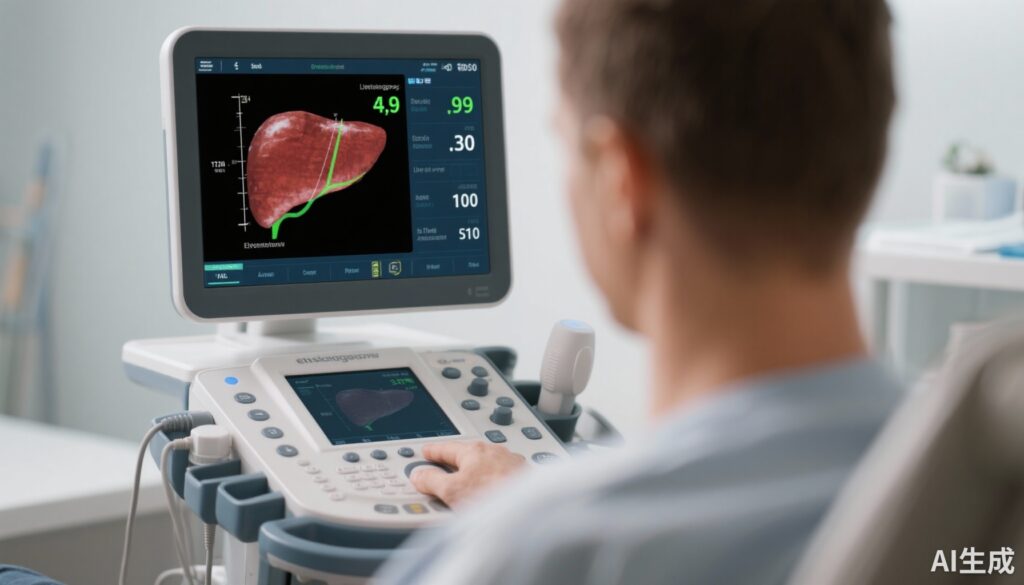Highlight
- Discordance between liver stiffness measurement (LSM) and biochemical response occurs in over half of PBC patients.
- The most recent LSM (LSMc) is the strongest predictor for first hepatic decompensation regardless of biochemical response or prior LSM trends.
- Patients with LSMc >10 kPa have a significantly increased risk of hepatic decompensation, independent of biochemical response status.
- Biochemical response remains prognostically relevant mainly among patients with stable or improved LSM, underlining a nuanced interplay between markers.
Study Background
Primary biliary cholangitis (PBC) is a chronic autoimmune liver disease characterized by progressive destruction of intrahepatic bile ducts, leading to cholestasis, fibrosis, and eventually cirrhosis with risk of hepatic decompensation (HD). Accurate prognostication is crucial to optimize monitoring and guide therapeutic interventions, including the timing of liver transplantation (LT). Traditional prognostic assessment has centered around biochemical response criteria, such as the Paris-2 criteria, which evaluate improvements in alkaline phosphatase and bilirubin following ursodeoxycholic acid therapy. Concurrently, noninvasive liver stiffness measurement (LSM) by elastography has emerged as a direct marker of hepatic fibrosis, providing valuable prognostic information. However, clinical practice increasingly reveals discordant changes between LSM and biochemical response, raising uncertainty over their respective prognostic contributions and how best to interpret them.
Study Design
This international, multicenter observational cohort study enrolled 1,793 patients with PBC who underwent at least two reliable LSM assessments, taken at least six months apart. Patients with a history of hepatic decompensation, liver transplantation, or hepatocellular carcinoma prior to baseline were excluded to focus on first liver-related events. Biochemical response was defined according to the established Paris-2 criteria. LSM response was characterized as stable or any reduction in liver stiffness between measurements. The primary endpoint was first hepatic decompensation, including ascites, variceal bleeding, hepatic encephalopathy, or jaundice. Secondary endpoints were liver transplantation and liver-related death. Statistical analysis involved Cox proportional hazards regression to evaluate associations between LSM, biochemical response, and clinical outcomes.
Key Findings
Over a median follow-up of 22 months (interquartile range 12–39 months), 3.3% of patients developed hepatic decompensation. Strikingly, up to 55% of patients exhibited discordance between LSM response and biochemical response. Among patients demonstrating an LSM response (stable or decreased stiffness), those achieving biochemical response per Paris-2 criteria had a substantially lower risk of hepatic decompensation (hazard ratio [HR] 0.25, 95% confidence interval [CI] 0.06–0.97, p=0.044). Conversely, in patients achieving biochemical response, LSM response did not significantly modify the risk of hepatic decompensation (HR 0.64, 95% CI 0.21-1.96, p=0.429).
Importantly, a current or most recent LSM exceeding 10 kPa was a robust independent predictor of hepatic decompensation (HR 14.5, 95% CI 6.9–30.6, p<0.001), regardless of biochemical response status or previous LSM trajectory. This underscores the critical prognostic supremacy of LSMc over earlier liver stiffness measures and biochemical markers.
Regarding secondary outcomes, patients with elevated LSMc similarly showed increased risk for liver transplantation and liver-related mortality, although detailed statistics were not provided.
Expert Commentary
This large-scale, international study delivers pivotal insights into the prognostic dynamics of PBC, clarifying clinical dilemmas surrounding discordant biomarker changes. The frequent incongruence between biochemical response and LSM responses highlights that they capture distinct facets of disease progression: biochemical markers reflect ongoing cholestasis and inflammatory control, while LSM primarily indexes fibrosis burden and portal hypertension risk.
Notably, the dominance of current LSM over historic values or biochemical response signals a potential paradigm shift—longitudinal tracking of liver stiffness might be less critical than once thought when the latest measurement is available. Clinicians might thus prioritize prompt LSM assessment to recalibrate risk rather than rely extensively on past trajectories or biochemical criteria alone.
However, the study’s follow-up duration was relatively short, and the 3.3% event rate suggests a need for caution before universal clinical adoption. Moreover, routine LSM availability and operator-dependent variability in elastography should be considered when interpreting results. The interplay between LSM and biochemical responses could reflect complex pathophysiologic mechanisms including evolving fibrosis, inflammation, and bile duct injury that merit further translational research.
Current guidelines still emphasize biochemical response as a marker to guide therapeutic decisions, but this study supports integrating contemporaneous LSM into holistic prognostication frameworks. Future studies might elucidate if combined stratification using LSM and biochemical markers can optimize timing for second-line agents or LT referral.
Conclusion
In conclusion, this comprehensive investigation establishes the most recent liver stiffness measurement as the strongest predictor of first hepatic decompensation in primary biliary cholangitis, overshadowing prior biochemical response status and LSM trajectories. Given that discordance between biochemical and LSM responses is common, clinicians should consider current LSM results paramount when assessing prognosis and planning management. These findings advocate for wider incorporation of LSM into routine PBC monitoring to improve earlier risk detection and inform clinical decisions.
Funding and ClinicalTrials.gov
The study was conducted by the Global & ERN Rare-Liver PBC Study Groups with multi-institutional funding support, as detailed in the original publication. There is no specific ClinicalTrials.gov registry number listed.
References
1. Wong YJ, Lam L, Soret PA, et al. Prognostic value of liver stiffness measurement vs. biochemical response in primary biliary cholangitis. J Hepatol. 2025 Oct 3:S0168-8278(25)02519-X. doi: 10.1016/j.jhep.2025.09.024.
2. European Association for the Study of the Liver. EASL Clinical Practice Guidelines: The diagnosis and management of patients with primary biliary cholangitis. J Hepatol. 2017;67(1):145–172.
3. Parés A, Caballería L, Rodés J. Update in primary biliary cirrhosis. J Hepatol. 2006;44(4):677-685.



